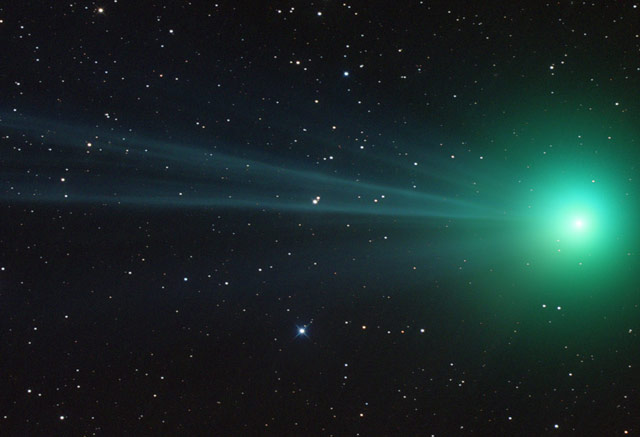Stars

ABC of Astronomy – B Is for Bok Globule 
B is for Bok globule, a kind of dark nebula studied by Bart Bok. B is for Bayer who invented a handy system of star designations beginning with a Greek letter. And B is for Baily´s beads. You won´t find them in a jewelry shop, but you might see them in a solar eclipse, as Francis Baily did.
ABC of Astronomy – D Is for Double Star 
We're used to having just one Sun, so the planet Tatooine in George Lucas's Star Wars was exotic with its double sun. Yet at least half the stars we can see in the sky are doubles. But a "double star" can be a true binary or just an optical double, which is a chance alignment of unrelated stars.
Alpha Centauri – 10 Facts about Our Neighbor 
The Solar System's nearest neighbor is the triple star system commonly known as Alpha Centauri. Two of the stars are similar to the Sun, and there are two confirmed planets orbiting a red dwarf.
Annie Jump Cannon 
Oh! Be a fine girl (guy)--kiss me! This is the traditional mnemonic for the way stars are classified: OBAFGKM. Find out about the astronomer and suffragette who devised the system and who said that astronomical spectroscopy made it "almost as if the distant stars had acquired speech."
Arcturus - the Bear Guardian 
Arcturus is the brightest star in the constellation Boötes (the Herdsman) and the fourth brightest in the entire sky. It's been prominent in the skylore of many cultures for thousands of years, opened a World Fair, and may have been born in another galaxy.
AstroFest 2021 – An Evening with the Stars 
European AstroFest in 2021 is Worldwide AstroFest. The venue isn't Kensington, London, but rather the World Wide Web. In “An Evening with the Stars” we learned about the hunt for the Universe's first stars, what the stars have meant to humanity, and what was up with Betelgeuse.
Betelgeuse - Orion's Red Supergiant 
Betelgeuse is the star that represents the right shoulder of Orion the hunter. It's also one apex of the Winter Triangle, and it marks the center of the Winter Hexagon. Being bright red-orange and part of the hunter's commanding presence, it's not hard to find in the winter sky.
Cancer the Crab 
Cancer the crab scuttles across the late winter sky, well away from its nemesis Hercules. Cancer is a zodiac constellation, the Tropic of Cancer is named for it, and it has existed for over three thousand years. Yet it seems to be a dim and unremarkable constellation. Why all the attention?
Constellations 
Did you know there are 88 official constellations? Learn what they are and how to find them. On cloudy nights you can read the ancient myths and legends that tell their exciting stories.
Cosmic Ghosts, Ghouls and Vampires 
Astronomers use colorful language for cosmic objects. But unlike ghosts, ghouls and vampires in horror stories, the cosmic ones aren´t scary late at night. Here are tales of the birth, evolution and death of stars, a blinking demon and a star that, at Halloween, seems like the Sun´s ghost.
Do Red Dwarfs Live Forever 
Looking up at a clear, dark sky, you can see thousands of stars. Yet without binoculars or a telescope, the most common type of star is invisible. These are the small, cool red dwarfs that fill the sky and live practically forever.
Epsilon Eridani - A Norse God in the River 
Eridanus is the great river that flows through the southern sky. One its stars, Epsilon Eridani, is of special interest to us because of its nearness and because the sunlike star has a planetary system. Benefiting from a new IAU naming policy, the star and its planet are now also Ran and AEgir.
Galactic Winter Games 
Welcome to the Galactic Winter Games, a starry tribute to Earth´s Winter Olympic Games. It´s a tour of some really cool cosmic sights – as well as some hot ones, such as one of the biggest explosions in the Universe.
Gemini - the Celestial Twins 
Gemini. A story of the love and loyalty of two brothers parted only by death. Includes a star that´s actually a system of six stars, and a giant star that can help us measure distances in space. Contains an object that completely baffled astronomers for twenty years.
Heavens-Above – website 
You can see the International Space Station from where you live. But when and from which direction? What are the two bright stars you´ve seen after sunset? What´s an Iridium flare? The website Heavens-Above is a tool for beginners and experienced observers to answer questions like this.
How Big Are the Biggest Stars 
What is the biggest star yet discovered? It's harder than you might think to answer this question. But here's a short tour of big, bigger and absolutely enormous stars - including some impossible ones.
How Many Stars in the Dipper ? 
The Big Dipper is part of the constellation Ursa Major. It's probably the best known star group in the sky. And it has seven stars. Or does it? Let's take a closer look at at the star Mizar in the middle of the handle.
Naming Stars 
The International Astronomical Union is the official body in charge of naming celestial objects. But how do they name stars? Do all the stars have names? Can you buy a star name for a friend?
Pleiades - the Seven Sisters 
The Pleiades - the Seven Sisters - were shown in star catalogs six thousand years ago. Visible from northern and southern hemispheres, probably every culture that ever watched the sky had a name for them. But what is this group of stars? And are there actually seven of them?
Polaris - 10 Fascinating Facts 
Today we travel paved roads using good maps or a GPS system to find the way. Imagine sailing uncharted waters or journeying through trackless deserts without such help. In the northern hemisphere one of the greatest of navigational aids has for nearly two thousand years been the north star Polaris.
Polaris – Facts for Kids 
Polaris, the North Star, has been a navigation star for 1500 years. It´s easy to find using the pointer stars of the Big Dipper. Did you know that it hasn´t always been the North Star? Or that it´s really three stars?
Red Dwarfs - Ten Facts for Kids 
If you go outside on a clear dark night, you might see a few thousand stars. But without a telescope, not a single one will be the most common type of star in the Universe. You won´t see red dwarfs, the stars that will still be shining in the far distant future when all the others have died.
Smallest Star in the Universe 
No one could possibly say that a star is the smallest one in the whole Universe. But the smallest known star is 2MASS J05233822-1403022, which is a pretty big name for a star that's about the size of Saturn. Could there be even smaller ones as yet unknown?
Spring Triangle – a Seasonal Asterism 
There are 88 official constellations covering the sky with no gaps or overlaps. There are also lots of asterisms, recognizable patterns of stars that aren't constellations. They have no official standing, but they have the advantage over many constellations of resembling what they represent.
Stellar Misunderstandings 
If stars aren't white, why isn't the night sky more colorful? If it's 93 million miles to the Sun, how many times farther away is the next nearest star? Will the Sun become a black hole and suck us in? Here's a short explanation of some common misconceptions about the stars.
Taurus the Bull 
In Greek myth Taurus is Zeus´s guise for the seduction of Europa. Yet the bull´s red eye still glares at Orion in an enmity created long before the rise of ancient Greece. Today´s Taurus is a constellation memorable for its two beautiful star clusters and one of the sky´s most amazing objects.
Who Let the Dogs out? 
Someone must have left the door open, because the skies are full of dogs. You can see the dogs of Orion and the hunting dogs of the shepherd Bootes in pursuit of the Great Bear. There is also the Running Dog Nebula and the memory of poor Laika, the first cosmonaut, who perished in space.
Top Ten Articles
Previous Features
Site Map
Content copyright © 2018 by . All rights reserved.
This content was written by . If you wish to use this content in any manner, you need written permission. Contact Mona Evans for details.







